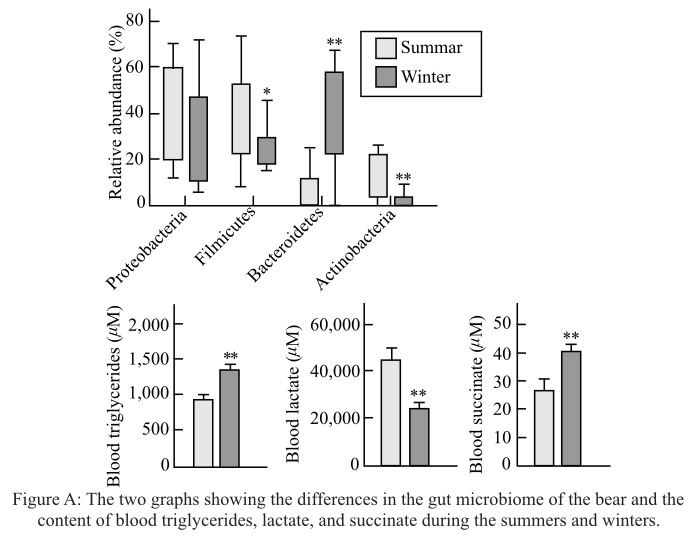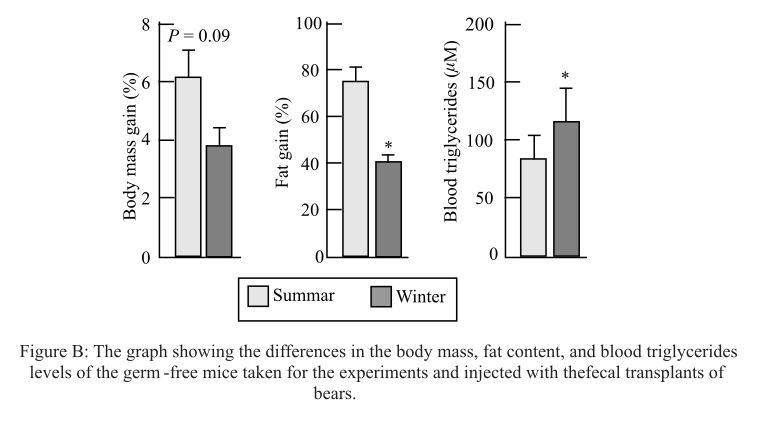
Concept explainers
To review:
The changes in the gut microbiome of bears during winters and summers.
Given:
The brown bears (Ursus arctos) were taken by the researchers for studying the role of gut microbiota in the digestion of food and in many other aspects of nutrition. Brown bears undergo hibernation when the environment is extreme cold. They analyzed whether the microbiome of the bear’s gut was different before and after fasting. They studied the blood and the fecal samples from 16 free-ranging brown bears during hibernation (February or March) and following hibernation (June). There was presence of different microbe communities in different amounts during different seasons and same was with triglycerides and other nutrients.
The following graphs were plotted after observing the conditions in winters and summers. Graph 1 shows the presence of different composition of the microbiome during different seasons. Also, the differences in the blood levels of triglycerides, lactate, and succinate are depicted.
The effects of the microbiota were also examined after introducing them into germ-free mice. Germ-free mice, unlike normal mice are devoid of gut microbiota and are unable to gain mass when they are kept on a high-fat diet. Fecal transplants from summer and the winter bears were given to the germ-free mice. Graph 2 shows the changes in body mass, fat content, and blood triglyceride levels of the mice after two weeks.

Graph 1: The two graphs showing the differences in the gut microbiome of the bear and the content of blood triglycerides, lactate, and succinate during the summers and winters.

Graph 2: The graph showing the differences in the body mass, fat content, and blood triglycerides level of the germ-free mice taken for the experiments and injected with the fecal transplants of bears.
Introduction:
There are a number of microbes present in the gut of bears. They help in digestion of the food. The more the amount of a particular microbe, the more will be the digestion by that microbe. There is a difference in the amounts of the different microbes in the gut during summers and winters in order to digest different products in the gut.
Want to see the full answer?
Check out a sample textbook solution
Chapter 50 Solutions
Life: The Science of Biology
- What would be the best way to make nonbiologists aware of the ecological and economic costs of global warming as it affects coral reefs and jelly populations?arrow_forwardIs the human gut microbiome contains trillions of microbes that both influence and are influenced by emotional and cognitive areas of the brain?arrow_forwardLooking at the composition of young children's gut microbiomes and how it changes under various environmental conditions, would the composition of a child's gut microbiome change depending on what part of the world that they live? why ? For example Asia vs Africa.arrow_forward
- A microbiologist argued that there is no such thing as “normal” microbiota of the human body, since the population is dynamic and is constantly changing, depending on diet and external environment. What would be an argument against this microbiologist’s view?arrow_forwardContrast r- and K-selected adaptations.arrow_forwardHave you ever heard of anthrax disease? Does it have different effects on Humans than livestock species? If so, what are those differences? and give a cite source where you find the answerarrow_forward
- In response to the following question, write a sentence outline and an essay.In what ways are pandemics and endemics similar and in what ways/way arethey different?arrow_forwardWhen a fish is alive, how does its microbiome change? When it is chopped up and filleted, how does it change?arrow_forwardDescribe the amensalism observed in attine ant communities. What other types of interactions are present in these communities?arrow_forward
- Health Safety And Nutrition F/Young ChildHealth & NutritionISBN:9781305144767Author:MAROTZPublisher:Cengage
